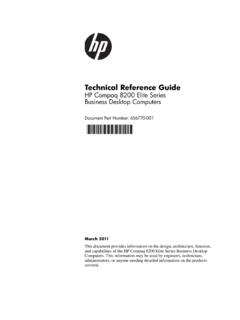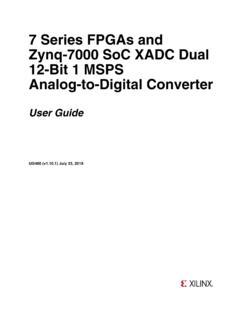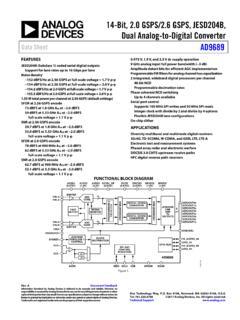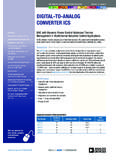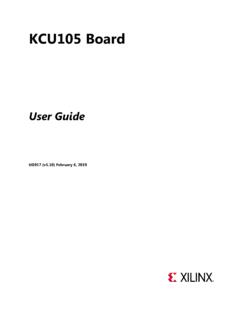Transcription of ESP8266 Weather Station User Guide V 1.0 Mar 2017
1 ESP8266 Weather Station user Guide V Mar 2017 Contents 1. Introduction .. 4 2. Assembly .. 5 A. ESP8266 Module .. 5 B. OLED Display .. 6 C. DHT11 Humidity & Temperature Sensor .. 7 D. Wires & Cables .. 8 3. Tool Setup .. 9 A. Download and Install the Serial Driver .. 10 B. The Arduino IDE .. 11 C. Install the ESP8266 tool chain .. 12 D. Selecting the Correct Board .. 13 E. Setting the Correct Port .. 14 F. Testing the Setup: WiFi Scanner .. 15 G. Summary .. 16 4. ESP8266 Programming Basics .. 17 A. Preparation .. 17 B. The Arduino Sketch .. 18 C. Hello World: The serial console .. 19 D. Input/Output: GPIO pins .. 21 E. Interrupts .. 23 F. Measuring analog signals .. 24 G. WiFi .. 25 H. HTTP .. 26 5. The ESP8266 WeatherStation .. 30 A. Installing the 30 B. Open the Weather Station Example .. 32 C. Getting the OpenWeatherMap API Key .. 33 D. Configuring the Weather Station .. 34 E. Connecting the Hardware .. 35 F. First Run .. 37 G.
2 Summary .. 38 6. The WeatherStation Code Explained .. 39 A. The JSON Streaming 39 B. The Grammar .. 41 C. The JSON Streaming Parser 42 D. Conclusion .. 44 7. Collecting and Displaying Local Data .. 45 A. The Climate Node Setup .. 45 B. Thingspeak Setup .. 46 C. Programming the Climate Node .. 48 8. More 49 A. The ESP8266 PlaneSpotter .. 49 B. The ESP8266 WorldClock .. 50 The ESP8266 WeatherStation is one easy way to get started with the ESP8266 and IoT. The included Guide helps you step-by-step to setup an internet connected Weather Station which shows current and forecasted Weather information. The Uctronics ESP8266 WeatherStation Kit has the advantage that everything fits together, but you can of course also get the components from your preferred supplier. In this chapter I will quickly go through the minimal requirements and the options you have to build your first WeatherStation. A. ESP8266 Module There are many different modules available based on ESP8266s, they differ in a number of aspects such as the quantity of available GPIO pins or if they can be programmed easily without need of an additional Serial-to-USB converter .
3 If you are a beginer I suggest you use a developer-friendly module like the NodeMCU or the Wemos D1 mini. They come with a USB connector and have the maximum number of available pins ready for your usage. The absolute minimal requirement is that your ESP8266 module has at least two free GPIO pins to connect it to the OLED display. B. OLED Display With the display, you also have many options: do you want the pixels to be white or blue, or do you even prefer a two-color display where the footer is in one color and the rest in another? What really matters is the driver chip and the protocol. The OLED library currently supports I2C and SPI for both the SSD1306 and the SH1106 chip. The first is often used for inch displays while the second one is used for displays. Displays with SPI interface will consume more of your free GPIO pins. C. DHT11 Humidity & Temperature Sensor This DHT11 Temperature & Humidity Sensor features a temperature & humidity sensor complex with a calibrated digital signal output.
4 By using the exclusive digital-signal- acquisition technique and temperature & humidity sensing technology, it ensures high reliability and excellent long-term stability. This sensor includes a resistive-type humidity measurement component and an NTC temperature measurement component, and connects to a high-performance 8-bit microcontroller, offering excellent quality, fast response, anti- interference ability and cost-effectiveness. D. Wires & Cables You will also need some wires to connect the display to the ESP8266 . In case you want to connect the display directly to the NodeMCU you will need at least four female-to-female jumper wires, since both the display and the NodeMCU have male pin headers. The wires don t need to be long, (20cm) is usually enough. To program the ESP8266 module you will also need a micro USB cable. In case of the NodeMCU this cable should have a micro-USB connector on the module side and a normal USB connector for your PC or Mac.
5 3. Tool Setup In this chapter, we will prepare your development environment by installing all the tools necessary. Drivers are needed to communicate with the ESP8266 , a tool called Arduino IDE will let us write code, and a sample project will prove that the components are working well together. A. Download and Install the Serial Driver To program the NodeMCU , your development platform (PC, Mac, Linux) needs to detect the Serial-To-USB adapter soldered onto the ESP8266 module. This ESP8266 development module has built in a high-quality Labs CP2102 Single-Chip USB to UART Bridge with Micro- USB connector that baud rates up to 921600. You can download and install the driver from here: B. The Arduino IDE The Arduino Integrated Development Environment (IDE) is the tool you will use to program the ESP8266 . IDEs are more than just editors; they help you with various tasks during the development process. To install the Arduino IDE, go to and download the latest version matching your operating system: For Mac OS X, you can download a ZIP file which you then have to extract.
6 Take the extracted application Arduino and move it to your Applications folder. For Windows, you have the option between an executable installer and a ZIP file. The ZIP file might be the better option if you do not have administrator permissions on your system. The installer on the other hand can put the libraries in the proper places. C. Install the ESP8266 tool chain A tool chain is the set of tools that lets you compile and create binaries for a certain platform. Since we want to create binaries for the ESP8266 we need a different tool chain than the one that comes with the plain vanilla Arduino IDE. The Arduino IDE has a wonderful feature, Board Manager, to save you the hassle of downloading many different files and copying them into obscure locations. It lets you install support for many different chips and boards with just a few clicks. But first of all we have to tell the Arduino IDE where it should look for board definitions: Open the Arduino IDE Go to your preferences/settings and in the text box Additional Board Manager URLs enter this URL: Now go to Tools > Board.
7 > Boards , search for the ESP8266 board and click Install. Get a coffee and wait until it finishes. From time to time you want to come back to the Board Manager and make sure that you have the latest version of the ESP8266 tool chain installed. To do that simply click on the ESP8266 entry and select the latest version from the dropdown. Then click Update. D. Selecting the Correct Board Now your Arduino IDE knows about ESP8266 boards in general. But not all the ESP8266 boards are the same; there are subtle but important differences in available Flash Memory and how they can be programmed. The selection of the correct board also defines the names of the GPIO pins: the designers of the NodeMCU decided to introduce a completely new naming scheme for the pins. Instead of calling them GPIO1, GPIO2 etc they decided to give them different numbers by using a D - prefix. So D0 is GPIO16, D1 is GPIO5 and so on. By selecting a NodeMCU board you automatically have the D naming scheme available, and this helps a lot since these names are also printed on the module board.
8 So, let s pick the correct board. If you bought the original Squix Starter Kit you will have to choose a NodeMCU : Go to Tools > Board: * > NodeMCU (ESP-12E Module) There is a plentitude of modules available. Please make sure that you have the correct board selected before you continue. E. Setting the Correct Port Serial interface: At the hardware level the ESP8266 is programmed through a serial interface. In short this is a very common communication interface which normally requires three lines: transmit (TX), receive (RX) and ground (GND). Both devices involved in the communication need to agree on the rate the characters are sent over the wire. This rate is usually measured in BAUD. 10 BAUD is equal to 1 character per second. Your average PC or Mac doesn t have such a serial interface, so how can we program the ESP8266 ? This is done through a Serial- to-USB converter . Some ESPs already come with a built-in converter ; others need an external one for programming.
9 In an earlier step, you already installed the drivers for this converter . If everything went well and the board is plugged into your computer you should now be able to select the serial connection. It should show up in the Menu under Tools > Port. On my Mac the device is called / USBtoUART. On a PC it should be listed as a COM port labelled COM# (where # is some number). If you cannot see a device that looks like the NodeMCU, try to unplug the ESP module and re-plug it after a few seconds. Also try a different USB socket. If that doesn t help consider restarting your Make sure that you installed the driver as mentioned in the chapter about drivers. F. Testing the Setup: WiFi Scanner Thanks for bearing with the complicated preparation until getting to the really cool part. We are going to run our first program on the NodeMCU! In the Menu of the Arduino IDE go to File > Examples > ESP8266 Wifi and select WiFiScan. A new window will open up.
10 This window is your current project and is also called a Sketch . To compile and transfer the binary to the ESP8266 click on the green circle that contains an arrow on the very top of the window. If everything went well this will compile the sketch andupload the binary to the ESP. It might look something like this: Wifi Scanner Output If you see Done uploading. in the window, then click on the magnifying glass on the top right of the window. This is the serial console that you can use to see output from the NodeMCU module, or to send commands to the device. Make sure that the baud rate is set to 115200. This rate is also set in the example code, and if you have a different setting the ESP will talk with a different speed than your PC listens. You can set the baud rate on the bottom left of the serial monitor. My output looks like this: Serial Console of the Wifi Scanner If you see something similar: congratulations! You have just set all the preconditions to run the WeatherStation code.

